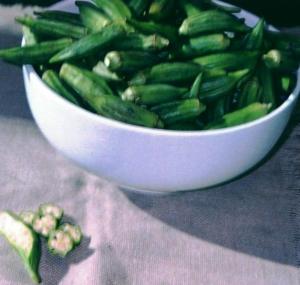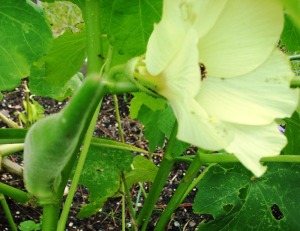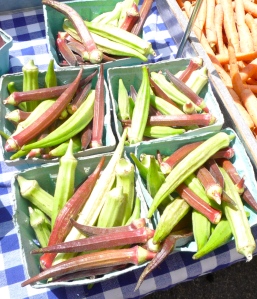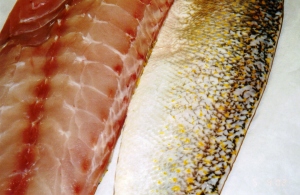Okra
Okra, (hibiscus esculentes), is a native African plant that is now known in the United States in Southern cuisine. It became a staple to the African-American slaves.
The word okra came from the Twai Language in West Africa of nkruma; and from the Buntu Language in South and Central Africa of gumbo.
The Okra is botanically a fruit, bearing many small white seeds inside. The fruit ranges in size up to a few inches long. It has tapered body, with slight ridges running around the pod. On the stem end, it looks like a little cap. The skin is a deep green, (though there are several red tinted varieties), and covered in a slight fuzz. The seeds inside are small are pearly white. They are attached to the flesh. Inside the flesh, there is a slick gummy substance, which gives okra a natural thickening ability. The plant is covered with stingers. It produces yellow, hibiscus like blooms. The flowers are also edible.
Okra grows in hot weather climates. It is related to cotton. Choose smaller pods, if possible. The larger the pod, the more the tendency to become leathery. The okra plant is naturally drought tolerant.
Okra is best known for its role in Gumbo, a spicy, southern stew with sausage, chicken, and rice. Okra also pairs well with tomatoes, and other acidic flavors. Often, okra is breaded and deep-fried, or pickled.
What tastes good with Okra
Basil
Butter
garlic
hollandaise sauce
lemon
onions
parsley
pepper,black
peppers, esp. green
tomatoes
vinaigrette
Okra Fritters
1 cup flour
1/2 cup cornmeal
1/4 cup grated parmesan
1 medium yellow onion, peeled and minced
3 eggs, lightly beaten
1 1/4 cups evaporated milk
2 tsp salt
1/2 tsp cayenne
1 lb okra, rimmed and thinly sliced
1 cup vegetable oil
Mix together flour, cornmeal, parmesan, onions, eggs, evaporated milk, slat and cayenne in a large bowl. Add okra and set aside.
Heat oil in a large nonstick skillet over medium heat. Make 4 to 5 fritters at a time by spooning 2 tbsp of the batter for each fritter into skillet, keeping about 3” between fritters and using a spatula to flatten each mound into a 3 1/2” pancake. Fry until bottoms turn golden, about 2 minutes; flip and continue frying until center is cooked through, about 2 minutes more. As fritters are finished, transfer to paper towels to drain. Repeat process with the remaining batter, making 25-30 fritters in all.
Serves 6 to 8.
© 2013 Chef Jennifer M. Denlinger All rights reserved
Please contact me for permission to use or reference this work.
Please contact me if you wish to receive “Food For Thought” in your mailbox.




